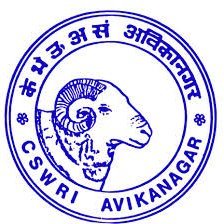Quick Contact +91-11-25842122
 ICAR-Central Sheep and Wool Research Institute (CSWRI)
ICAR-Central Sheep and Wool Research Institute (CSWRI)Avi-Batika
Background
Enteric methane emissions from ruminants pose a dual challenge to the livestock industry: significant energy loss and a major contribution to greenhouse gas emissions. Methane production accounts for approximately 10-13% of digestible energy loss in ruminant diets, reducing feed efficiency and overall productivity. Furthermore, methane is a potent greenhouse gas with a global warming potential over 25 times greater than carbon dioxide. making its reduction a priority in climate-smart livestock production systems.
Conventional strategies to reduce methane emissions often involve costly additives or synthetic compounds that may not be sustainable or practical for smallholder farmers. Meanwhile, large quantities of agricultural crop residues and by-products-particularly straw remain unutilized or are wasted, contributing to environmental degradation through open-field burning or decomposition
There is a pressing need for a sustainable, cost-effective solution that can both reduce enteric methane emissions and improve feed efficiency using locally available materials. Additionally, with the growing demand for livestock products and the increasing gap between feed demand and supply, developing alternative feed resources that are nutritionally balanced, environmentally friendly, and economically viable is essential.
Avi-Batika addresses these critical gaps by converting agricultural waste into a complete feed block enriched with natural bioactive compounds that inhibit methane production in the rumen. This innovative approach not only supports higher livestock productivity but also promotes environmental sustainability and resource efficiency in animal agriculture.
Technology Details
Avi-Batika is a scientifically formulated complete feed hlock developed by ICAR-CSWRI using underutilized agro-residues and plant-based bioactive compounds. This innovative technology not only meets the nutritional needs of ruminants but also contributes to enteric methane mitigation, improving feed conversion efficiency and reducing the carbon footprint of livestock systems.
Key Technical Features:
Utilization of agricultural waste: Avi-Batika converts locally available, nutritionally viable but underused crop residues (e.g., straw) into value-added feed resources.
Fortification with bioactive-rich plant materials: The feed block is enriched with natural
plant compounds that have been scientifically proven to modulate rumen microbial activity and inhibit methanogenesis.
Complete Feed Format: Designed as a compressed block that contains balanced proportions
of roughage, concentrate, minerals, and bioactive additives offering convenience in storage, handling, and feeding,
Methane Reduction: The incorporation of secondary metabolites (eg, tannins, saponins) suppresses methanogenic archaea and protozoa, redirecting hydrogen to more efficient fermentation pathways
Enhanced Digestibility and Performance: By reducing energy losses due to methane, more
digestible energy is made available for microbial protein synthesis, resulting in improved animal productivity.
Benefits:
Reduce methane emission hence e more environment sustainable feed for lowering carbon footprint in livestock.
Improved average daily gain (ADG) and feed conversion ratio (FCR)
Promotes sustainable use of agro-residues
Conversion of waste to worth, ensuring feed security by substituting conventional feed resources.
Encourages climate-resilient livestock production
Field Applicability: Suitable for all ruminant livestock including sheep, goats, cattle, buffalo, yak, Mithun etc. Avi-Batika is particularly beneficial for smallholder farmers, dairy entrepreneurs, and fodder-deficit regions seeking economical and eco-friendly feeding solutions.


